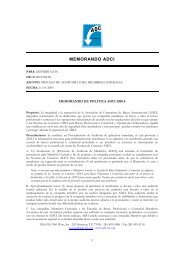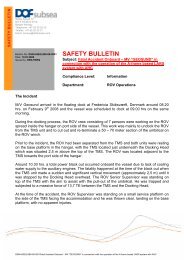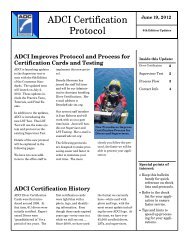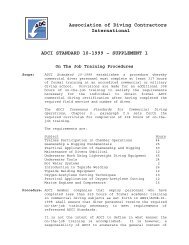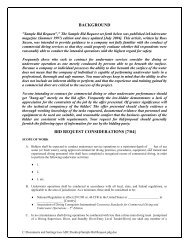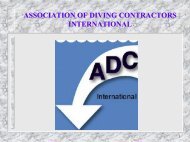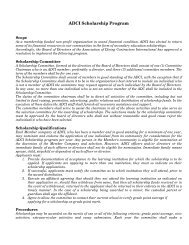DIRECTIVE NUMBER: CPL 02-00-151 EFFECTIVE DATE ... - OSHA
DIRECTIVE NUMBER: CPL 02-00-151 EFFECTIVE DATE ... - OSHA
DIRECTIVE NUMBER: CPL 02-00-151 EFFECTIVE DATE ... - OSHA
Create successful ePaper yourself
Turn your PDF publications into a flip-book with our unique Google optimized e-Paper software.
APPENDIX A: Commercial Diving Operations Questions and Answers<br />
This appendix consolidates <strong>OSHA</strong> interpretations related to commercial diving operations that<br />
have been issued and remain valid as of the date of this instruction. Previously issued<br />
interpretations were reviewed to determine their current validity and accuracy. Interpretations<br />
for which standard references have changed were updated to reflect the current standard<br />
reference.<br />
<strong>OSHA</strong> requirements are set by statute, standards, and regulations. The Agency’s interpretations<br />
explain these requirements and how they apply to particular circumstances, but they cannot<br />
create additional employer obligations. These responses constitute <strong>OSHA</strong>’s interpretations of<br />
the requirements discussed. Note that our enforcement guidance may be affected by changes to<br />
<strong>OSHA</strong> rules. Also, from time to time we update our guidance in response to new information.<br />
To keep apprised of such developments, you can consult <strong>OSHA</strong>’s website at:<br />
http://www.osha.gov.<br />
Question #1: Are diving operations involving the underwater inspection of bridges and other<br />
submerged structures considered to be “scientific diving” under 29 CFR 1910.401(a)(2)(iv),<br />
and if this diving is “scientific diving,” what standards apply to these divers<br />
Answer: The underwater inspection of bridges and other structures by divers is governed by<br />
<strong>OSHA</strong> regulations for commercial diving, 29 CFR Part 1910, Subpart T – Commercial Diving<br />
Operations. The exemption from <strong>OSHA</strong>’s commercial diving standard for scientific diving<br />
would not be applicable to underwater inspections of bridges or other submerged structures.<br />
Question #2: What are the minimum number of dive-team members required to support<br />
air dives using SCUBA equipment and surface-supplied diving equipment, with one diver<br />
in the water<br />
Answer: In establishing the number of dive-team members required for a dive, proper<br />
consideration must be given to 29 CFR 1910.421(d) Planning and assessment, 29 CFR<br />
1910.421(e) Hazardous activities, and 29 CFR 1910.422(b)(3). This latter provision requires<br />
employers to provide a means to assist an injured diver from the water (such as an inwater stage,<br />
small boat, or stokes basket) or into a diving bell, that may necessitate additional dive-team<br />
members.<br />
Commercial SCUBA air diving with one diver in the water requires a minimum of three diveteam<br />
members: a designated person-in-charge (DPIC) (see 29 CFR 1910.410(c)), a standby<br />
diver (see 29 CFR 1910.424(c)(1)), and a line-tended diver (see 29 CFR 1910.424(c)(2)). A<br />
tender who is a qualified diver can be the standby diver; for a three-person dive-team, the DPIC<br />
would assume tending duties when the standby diver (tender) is in the water. A DPIC also can<br />
be the standby diver, provided that: (1) he/she is a qualified diver, and (2) another dive-team<br />
member at the dive location is trained and capable of performing necessary DPIC-functions<br />
while the DPIC is in the water as the standby diver.<br />
Commercial surface-supplied air diving with one diver in the water requires a minimum of three<br />
dive-team members: a DPIC (see 29 CFR 1910.410(c)), and a diver “who shall be continuously<br />
A-1



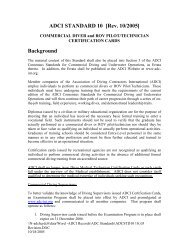
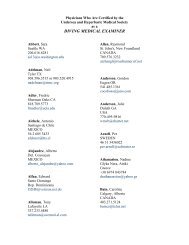
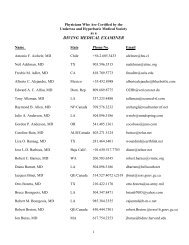
![SOLICITUD MEMBRESIA ASOCIADO [Rev 06/08] - Association of ...](https://img.yumpu.com/48291988/1/190x245/solicitud-membresia-asociado-rev-06-08-association-of-.jpg?quality=85)

